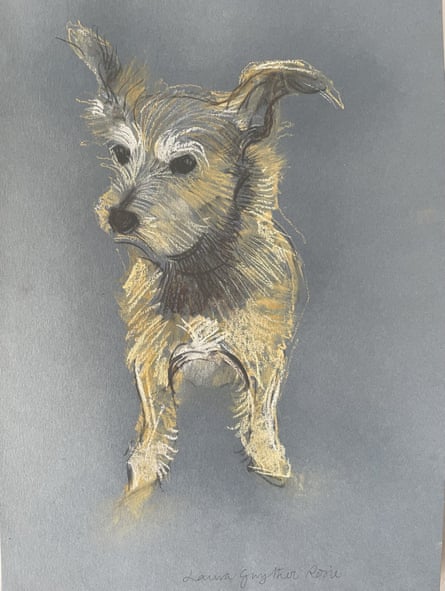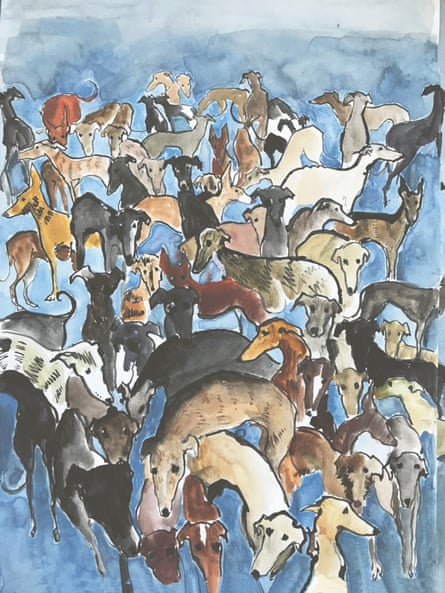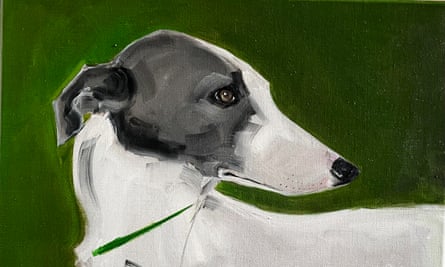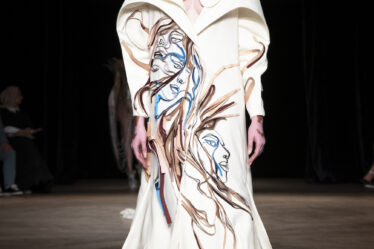
When a toast is raised at a wedding, it is invariably to the bride. Not so when artist and author Sally Muir married the journalist Geoffrey Wheatcroft back in 1990. That honour went to Fanny, Sally Muir’s “big-haired, lawless 80s mongrel” with whom she had fallen in love at first sighting in Battersea Dogs Home when she was 24 years old.
“Fanny was toasted as the person who brought us together,” laughs Muir, talking to me on Zoom from her studio at her Bath home, her grey whippet, Peggy, curled up in an old leather armchair behind her. “Geoffrey was mad about her.” And if he hadn’t been, would it have been a deal-breaker? The answer, after a moment’s delay is, of course, yes – her hesitation attributable to her comic timing, inherited, perhaps, from her late father, the comedy writer Frank Muir.
Dogs have always been in Sally’s life, ever since she was a child growing up in rural Surrey. Early on, she co-ran a knitwear business. Their red sweater featuring a black sheep was made famous by Diana, Princess of Wales, bought by David Bowie and Andy Warhol and worn by Emma Corrin in The Crown. Sally now paints and draws dogs for a living. “They have such a great attitude to life,” she says. “I find them endlessly fascinating.”
Communing with dogs as she does has taught Sally a good deal about optimism, resilience and trust and what it means to die a good death, for dogs and people alike. Her book of elderly canines, Old Dogs, was published in 2021. In her latest book, Rescue Dogs, she charts the symbiotic relationship between hounds and humans.
Fanny was a hard act to follow, but Jack Swan managed it. Sally was at art college, in her late 30s, her two children were still toddlers. A fellow art student found the “very damaged” greyhound eating from her bins and took him in. After moving in with Sally’s family, he ate the sofas, books and car seatbelts. A tiny dalmatian-Jack Russell cross called Dotty followed, and then Lily, a whippet rescue. “She was my shadow,” Sally says, “my alter-ego dog. We just understood each other.” Peggy the whippet puppy came next, acquired “on impulse” when Lily was seven. Lily was furious, and remained so.
Several years ago, Sally came across a distressing photograph of a group of abandoned galgos, the greyhound-like Spanish hunting dogs often maltreated by their hunter-owners in southern Spain. Her response was to draw their imploring gazes, long faces and lanky elegance in gouache, ink and charcoal.
“There was something about the way they were all standing packed in together in the kennel,” says Sally, who donated the drawing to Tina Wales Solera, a Briton who founded the rescue charity Galgos del Sol in Murcia in 2007. “They didn’t look particularly sad, but they were so patient and trusting and hopeful.”
Spending time with Solera’s galgos inspired Rescue Dogs, a collection of more than 150 portraits in oil, ink or charcoal, the medium determined by how shaggy or lean, doleful or mischievous the dogs were. “I love the thought of these dogs, who were unwanted by someone, being cherished in their new homes. Quite a few are damaged, mangy, old or miserable, but they strike some sort of chord in the person who sees them.”
“Nobody wanted him,” Crosby’s owner writes, “as he had a disfigured leg. He came into our lives at a time when I was dealing with severe anxiety and agoraphobia, and he played a pivotal part in my healing.”

“The fact that Crosby was mostly overlooked,” says Sally, “but one person was prepared to take him on is a great example of how rescuing is such a two-way thing for most people.”
It certainly was for the couple who took in Derek, a wise-looking mongrel. “We rescued him three years ago,” writes his owner, “but really he rescued us! After many years of trying to start a family, we had to stop, so he’s now our substitute child and thoroughly spoilt.”
Another owner writes of Millie, who “never had affection” but who “unlocked a capacity for love inside me that I didn’t know existed.” Rosie’s story mixes cruelty and compassion together. One night, a tourist stopped two dog-catchers from beating Rosie on a Mexican beach. “She started to sit outside my hut morning and night,” writes her owner. “One morning, I woke up and she was rolling four puppies into my hut.” Homes were found for them and Rosie went with her rescuer back to London. “It is the best decision I ever made. She is the love of my life.”
Fostering a rescue dog is always a risk, particularly so with galgos or podencos, another greyhound-like hunting breed. Galgos are mass-bred to hunt from September to February, often subjected to punitive training that includes being tied to moving vehicles. In February, upwards of 60,000 galgos a year are abandoned, tortured or killed, according to Galgos del Sol, in spite of anti-animal-cruelty laws.

Tina invited Sally to draw the Galgos del Sol rescues during their rehabilitation. “I would sit in their run, the dogs all over me, nicking my painting water and trying to eat all my pencils, thoroughly participating. They are beautiful dogs, mainly horribly abused, but they still rush up to you and want to be your friend and shove their noses in your face.
“There was a shy corner where all the very damaged dogs huddled together. They found comfort in each other.” Sally includes a drawing of two such survivors in Rescue Dogs, their forms partially outlined in charcoal, only their black noses confirming their presence.
The recurring theme in the book is of the rescued rescuing their new owners, says Sally, and of “the dog giving the human something they are otherwise lacking”. This makes perfect sense to Sally. Helping another creature have a better life “takes you out of yourself. You can’t curl up in a ball. They’ve got to be fed and looked after and taken out, whatever the weather.”
As her own dogs have approached death, Sally has leaned in. When Fanny was dying, Sally drew her at least once a day. “It felt like she was slipping away. It was a way of hanging on to a little bit of her. I have a painting of her in our bedroom that I drew the night before she died. It’s a very primitive response, isn’t it, having an image of a dead hound?”
There was no letting go of Jack Swan, sadly. He died suddenly, aged two, from a heart condition. “It was shocking.” Until then her two children, then 10 and 12, had only known the deaths of animals with short lifespans – gerbils and hamsters. “It was the first dog they could remember, and they loved him. We had a full funeral.” He is one of the many animals buried in their garden. “There’s a lovely apple tree on top of him.”
Lily died last summer. “She had a very good death. She did it magnificently,” says Sally, visibly moved. “She was winding down incredibly slowly, a bit like the Queen, dying of old age, giving out. There was lots of carrying her outside, her wagging her tail, very happy.”
A holiday for Sally’s brother’s 70th birthday loomed – “not something I could get out of. But I couldn’t put her down just because we were going on holiday”. Besides, “nobody wanted to look after her. It was like running an old people’s home here.” Then someone stepped in. “Her dog had recently died and she said she wouldn’t want her dog to have not been looked after just because she was old. But then, three days before I was going to leave, Lily just died. She couldn’t have done it better, really. She chose her moment and died next to me in her bed.
“Thinking of my parents, there’s a lot to be said for not too much intervention, and doing it on your own terms. Which my father managed, but my mother didn’t. I noticed with Lily and with various humans that you can be around for the last part, and sitting by the bedside makes you feel better, but basically there comes a point – and I could feel Lily disengaging from me – where they have to head off on their own.”
Rescue Dogs by Sally Muir (Pavilion Books, £14.99) is published on 16 February



